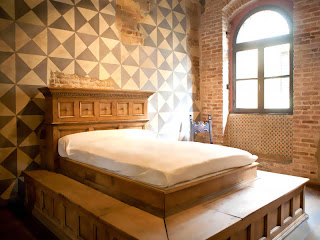The story was already popular in 14th century and there are at least three versions written by Italian authors
In 14th century Verona the two families of Montagues and Capulets were fighting one against the other... well, the rest of the story is well known.
 What not everybody knows is that like in many legends, also in Juliet and Romeo's (ladies first in Italy) story there is something true. The two families, Montecchi and Capuleti
in Italian, the struggle for power that took place in Italy and in
Verona at that time, the Scala family lords, are all true. In Verona
there are still the houses of the two families, nowadays of course
called Romeo's house and Juliet's house, with its famous balcony where is now also possible to get married.
What not everybody knows is that like in many legends, also in Juliet and Romeo's (ladies first in Italy) story there is something true. The two families, Montecchi and Capuleti
in Italian, the struggle for power that took place in Italy and in
Verona at that time, the Scala family lords, are all true. In Verona
there are still the houses of the two families, nowadays of course
called Romeo's house and Juliet's house, with its famous balcony where is now also possible to get married. The story was already popular in 14th century and there are at least three versions, written by Italian authors. Shakespeare version was part of a trend among writers and playwrights of the time to publish works based on Italian novellas. At the time of Shakespeare's Romeo and Juliet, Italian tales were very popular among theatre patrons. Critics of the day even complained of how often Italian tales were borrowed to please crowds. Shakespeare took advantage of their popularity, as seen in his writing of both All's Well That Ends Well and Measure for Measure (from Italian tales) and Romeo and Juliet. Shakespeare's version is an adaptation of the Italian Giulietta e Romeo, by Matteo Bandello. Bandello's story was translated into French and was adapted by Italian theatrical troupes, some of whom performed in London at the time Shakespeare was writing his plays. Although nothing is known of the repertory of these troupes, it is possible that they performed some version of the story. Bandello's version too was an adaptation of Luigi da Porto's Giulietta e Romeo.
The names of the families were actual political factions of the thirteenth century
 The latter gave the story much of its modern form, including the names
of the lovers, the rival families of Montecchi and Capuleti, and the
location in Verona. Da Porto is probably also the source of the
tradition that Romeo and Juliet is based on a true story. The
names of the families (in Italian, the Montecchi and Cappelletti) were
actual political factions of the thirteenth century, mentioned by Dante
in a short verse of his Divine Comedy
The latter gave the story much of its modern form, including the names
of the lovers, the rival families of Montecchi and Capuleti, and the
location in Verona. Da Porto is probably also the source of the
tradition that Romeo and Juliet is based on a true story. The
names of the families (in Italian, the Montecchi and Cappelletti) were
actual political factions of the thirteenth century, mentioned by Dante
in a short verse of his Divine Comedy
If you want you can also write to Juliet:
CLUB DI GIULIETTA
via Galilei 3
37100 Verona
Italy
via Galilei 3
37100 Verona
Italy
It's less romantic but also e-mails are ok:
Address: Via Cappello, 23 - 37121 Verona.Open Hours: Tuesday to Sunday 8,30-19,30 - Monday 13,30-19,30.
Tickets: Full € 6.00 – Reuced € 4.50 (group min. 15 persons and students from 14 to 30 years) – € 1.00 (School trips and kids from 8 to 13 years ) - € 1.00 for all on 1° Sunday of the month(from January to May and October to December) -Free for holders of Verona Card.
Telephone: 045 8034303
Photo Gallery













No comments:
Post a Comment